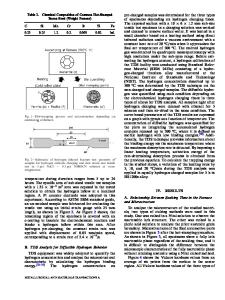Effects of the prior austenite grain size on the ductility of fully pearlitic eutectoid steel
- PDF / 3,717,328 Bytes
- 12 Pages / 594 x 774 pts Page_size
- 58 Downloads / 344 Views
I.
INTRODUCTION
IN addition
to their use as the reinforcing steel in prestressed concrete, eutectoid steels are used by the railroad industry for both rail stock and wheel material. ~The relative ease of obtaining a fully pearlitic microstructure by either continuous cooling or isothermal transformation, combined with "as-transformed" yield strengths which can exceed 760 MPa, constitute the major reasons for their use in the fully pearlitic condition. In addition, fully pearlitic eutectoid steels may be cold drawn into wire, a treatment/process which can impart yield strengths exceeding 1900 MPa while retaining a fair degree of ductility (e.g., e/= 35 pct) in the as-drawn product. Although the mechanical properties of pearlite have been studied for many years, considerable discussion continues regarding the microstructural parameters controlling its flow and fracture. Some of this confusion may have arisen due to attempts at extending results obtained on steels which were not fully pearlitic, to predict the behavior of fully pearlitic structures. The present work and the literature review provided is confined to microstructural effects on ductility in fully pearlitic eutectoid steels. A number of recent articles have reviewed the microstructural effects on deformation and fracture of fully pearlitic materials. 2~ The microstructural parameters which have been identified as affecting deformation include: the pearlite interlamellar spacing, Sp; the pearlite colony size; the pearlite nodule diameter; the carbide thickness and the prior austenite grain size. The first is controlled by the transformation temperature, while the austenitization temperature controls the last. 3 General agreement exists that Sp controls the yield strength, while the prior austenite grain size primarily controls ductility and impact toughness. However, the mechanism(s) by which these microstructural parameters exert their control on deformation and fracture is far from completely understood, as discussed below. Considerable previous work 3-15 has shown that the pearlite interlamellar spacing, Sp, controls the yield strength of JOHN J. LEWANDOWSKI, formerly Graduate Student, CarnegieMellon University, is now NATO Postdoctoral Fellow, Department of Metallurgy and Materials Science, University of Cambridge, Cambridge, CB2 3QZ, United Kingdom. ANTHONY W. THOMPSON is Professor, Department of Metallurgical Engineering and Materials Science, CarnegieMellon University, Pittsburgh, PA 15213. Manuscript submitted March 11, 1985. METALLURGICALTRANSACTIONS A
pearlite. Refinement of Sp increases the yield strength, presumably through the accompanying reduction in the spacing of obstacles (i.e., lamellar carbides). Although mathematical relationships of the form ~. = 0"0 + kS~ appear to describe the reported data, 3'4:~ discussion continues on the proper choice of exponent in the equation. 3'4"6:1-13 The post-yield deformation behavior of the pearlite also appears to be controlled by Sp. Figure 1 summarizes a proposed sequence for ductile fracture of
Data Loading...











